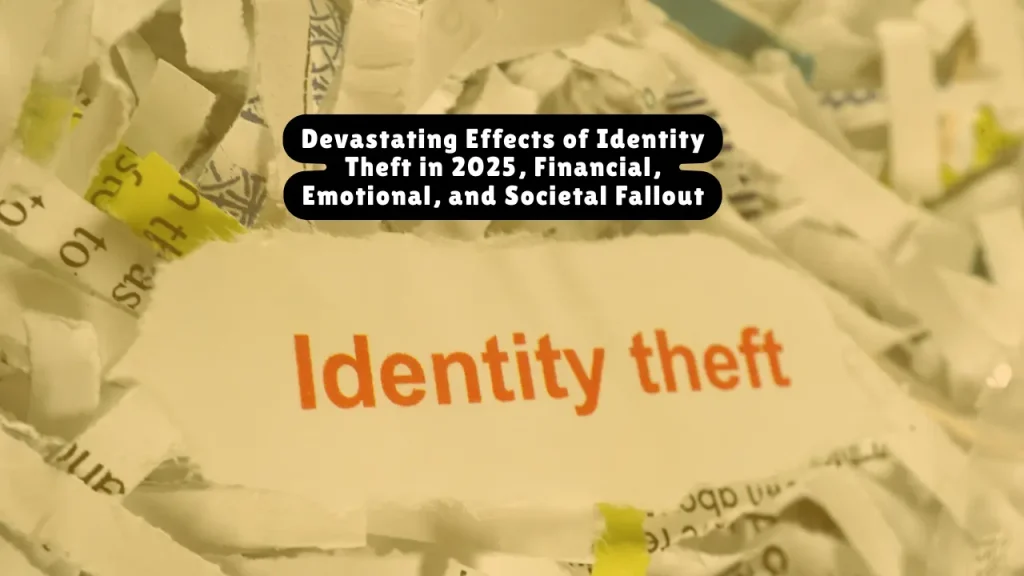Devastating Effects of Identity Theft in 2025, Financial, Emotional, and Societal Fallout
Identity theft has escalated from a financial nuisance to a global crisis. With fraudsters leveraging AI-driven scams and exploiting systemic weaknesses, the effects now stretch far beyond stolen funds. Victims suffer credit destruction, legal troubles, medical errors, wrongful arrests, and even social alienation—while businesses and government agencies lose billions each year.
This article offers a definitive, up-to-date look at the multidimensional effects of identity theft, filling in the critical gaps left by typical coverage. We examine financial loss, legal consequences, emotional trauma, the toll on children and businesses, and the rising risks of deep-fake fraud.
Table of Contents
1. Financial Devastation
Global and Individual Losses
Identity theft inflicted $23 billion in losses in the U.S. alone in 2023, with projections topping $50 billion globally in 2025. Individual victims lost an average of $1,600 per incident, up from $1,300 just a year earlier[^1^].
Credit Score Destruction
Criminals frequently open fraudulent accounts using stolen PII, causing victims’ credit scores to drop by over 100 points. These hits can remain on credit files for up to seven years, leading to loan denials, higher interest rates, and lost opportunities[^LifeLock^].
Mortgage and Deed Fraud
Thieves have impersonated homeowners to refinance mortgages, place liens, or even steal homes through fraudulent deed transfers—sometimes forcing victims into legal battles to reclaim property.
Direct Bank and Card Theft
Hackers and scammers gain access to accounts via phishing, ATM skimming, or credential stuffing, draining victims’ life savings in seconds.
2. Legal & Criminal Consequences
Wrongful Arrests and Criminal Records
Some identity thieves commit crimes under stolen identities, leading to innocent people being arrested. These cases can take months or years to resolve and require significant legal fees to clear the victim’s name[^OJP^].
Employment Barriers
Employers often perform credit and criminal background checks. A compromised identity can result in job offer withdrawals, license revocations (for nurses, teachers, etc.), or even job loss[^Harvard^].
Civil Litigation Costs
Victims may need to hire lawyers—at $150–$400/hour—to dispute debts and clear public records. Complex cases can cost over $5,000, especially if they involve civil suits against negligent creditors or data brokers[^PolicyGenius^].
3. Healthcare and Insurance Chaos
Medical Identity Theft
Thieves using stolen insurance data can contaminate medical records, leading to misdiagnoses, denied treatments, and wrongly documented conditions[^Aura^][^Experian^].
Insurance Premiums and Denials
Fraudulent claims can raise premiums or get policies canceled. Older adults and low-income individuals often suffer most, lacking the resources to correct errors[^NCBI^].
Related article: Number One Rule for Fighting Identity Theft Case

4. Government and Benefits Disruptions
Social Security & Medicare Fraud
Criminals may file for benefits under someone else’s SSN, causing legitimate claims to be denied or delayed for years[^LifeLock^].
Tax and Unemployment Fraud
The IRS reported a 116% surge in tax-related identity theft during early 2025. Victims often wait over 500 days to resolve issues through the IRS Identity Theft Victim Assistance (IDTVA) unit[^IRS^].
5. Psychological and Social Toll
Mental Health Impacts
80% of victims experience profound emotional distress, including anxiety, PTSD, and depression[^PolicyGenius^]. In 2024, 12% of victims contemplated self-harm, a disturbing reflection of the emotional toll[^Article2^].
Social Stigma and Isolation
Victims often face mistrust from friends or family, especially when financial troubles arise. This can lead to shame, withdrawal, and broken relationships—a largely overlooked impact.
6. Minors as Victims
Child Identity Theft
Children’s SSNs are unused for years, making them prime targets. By the time they apply for student loans or jobs, they may find decades of fraudulent debt tied to their identity. One in 40 U.S. households had a child identity theft victim in 2021[^Javelin^].
Recovery Costs
Parents must spend $1,000–$2,000 on legal and administrative fees to clear their child’s credit, along with the emotional strain of protecting their child’s future[^Aura^].
7. Impact on Small Businesses and Entrepreneurs
Business Identity Theft
Thieves can hijack Employer Identification Numbers (EINs) to take out fraudulent business loans or payroll advances. Many business owners have suffered $10,000–$50,000 in damages from such attacks.
Operational Disruption
Bank account freezes, broken vendor trust, and halted operations can devastate small businesses. Some cases require forensic accountants costing $200–$400/hour, with recovery expenses exceeding $20,000[^SmallBizForum^].
8. The Rise of AI and Deep-Fake Fraud
AI Impersonation
Criminals now use AI-generated deep-fake videos and voice clips to impersonate victims in real time. In one case, a man named William Woods was wrongfully institutionalized due to a convincing deep fake—only cleared years later through DNA[^VanityFair^].
Synthetic Identity Fraud
AI tools now generate thousands of fake personas daily by blending real and fake PII. These “synthetic identities” pass background checks, open credit lines, and go undetected for years[^IdentityGuard^].
9. Recovery Costs and Preventive Measures
Average Recovery Time & Cost
Victims spend 6–12 months disputing charges, repairing credit, and updating records. The total financial burden often exceeds $10,000, including time off work and therapy[^TheSun^].
ROI of Prevention
Credit-monitoring services cost $10–$30 per month, while potential savings from fraud avoidance can top $3,000+ per incident. Free credit reports via AnnualCreditReport.com offer a no-cost first step[^LifeLock^].
10. Actionable Prevention Tips
- Monitor Credit Regularly: Check reports quarterly; set up fraud alerts and dark-web scans.
- Freeze Credit When Needed: Prevent new accounts from being opened in your name.
- Report Suspicious Activity Immediately: File reports with the FTC, local police, and credit bureaus.
- Use Multi-Factor Authentication: Especially for financial, health, and government portals.
- Educate Your Family: Teach children and elderly relatives to avoid phishing scams.
- Secure Business Data: Encrypt EINs, secure employee records, and train staff.
Final Thoughts
Identity theft in 2025 is no longer just a consumer issue—it’s a public health crisis, a business liability, and a cybersecurity emergency. The emotional fallout can rival that of violent crime. Meanwhile, deep fakes and synthetic identities signal that the next evolution of fraud is already here.
By recognizing the far-reaching consequences and investing in proactive defense strategies, individuals, families, and businesses can not only recover—but resist and prevent future attacks.
About the Author

Sarah Klein, JD, is a former consumer rights attorney who spent years helping clients with issues like unfair billing, product disputes, and debt collection practices. At All About Lawyer, she simplifies consumer protection laws so readers can defend their rights and resolve problems with confidence.
Read more about Sarah
